The Copernicus Interactive Climate Atlas (http://atlas.climate.copernicus.eu, C3S Atlas in short) was released by the Copernicus Climate Change Service (C3S) in early 2024. It is a new C3S application (https://cds.climate.copernicus.eu/applications) which enables an interactive exploration of the Earth's climate, from recent changes and trends to possible climate futures under different emission scenarios. It uses key datasets that are available in the C3S Climate Data Store (CDS), including observation-based datasets (E-OBS), reanalyses (ECMWF’s ERA5, ERA5-Land and ORAS5), and comprehensive global (CMIP5/6) and regional (CORDEX) climate projections. The goal is to produce authoritative climate change information for a wide range of physical variables. The variables characterise various types of climatic impact-driving conditions (heat and cold, wet and dry, wind and radiation, snow and ice, ocean, circulation) relevant for climate change risk assessments. The C3S Atlas is a new resource for policy makers wishing to formulate effective climate policy and for other users who need to visualise and analyse climate change information, particularly at the regional scale. This C3S tool is an evolution of the Intergovernmental Panel on Climate Change (IPCC) Interactive Atlas (IPCC-IA), which was frozen in 2021 with the publication of the Sixth Assessment Report’s (AR6) WGI (Working Group I) section (see https://www.ipcc.ch/report/ar6/wg1).
The AR7 cycle has just started, and so the scope of the new Atlas has not been defined yet. In that sense, there is no formal agreement with the IPCC regarding the future. At the same time, the C3S Atlas has consolidated its role to become the natural evolution of the AR6 Atlas, and we believe the IPCC (WGI/II) might be interested in building on the C3S Atlas for AR7, in combination with other tools. We look forward to continuing the dialogue with the IPCC to ensure C3S can support the evolution of the IPCC's report in the most useful and efficient way.
The C3S Atlas has additional datasets and more variables than the IPCC‑IA, and it will have further enhancements in the future. One key additional feature is the possibility to select a country or multiple countries as predefined regions (e.g. a combination of Portugal and Spain is shown in Figure 1), or to compute regional products on-the-fly for any customised regions. This makes it possible, for instance, to select any transboundary regions, where the information provided by the C3S Atlas can support coordinated actions of multiple countries. In any of the predefined and user-defined regions, the user can visualise regional information products, such as time series, climate stripe plots or annual cycles. The C3S Atlas provides different options to download the different products and the underlying data, including the monthly gridded dataset of the full set of variables across the different datasets underpinning the C3S Atlas. See https://doi.org/10.24381/cds.h35hb680 for CDS access to the dataset. Figure 1 shows a screenshot of the C3S Atlas, illustrating its main components and some of the different products provided. Box A provides a summary of new features of the C3S Atlas.
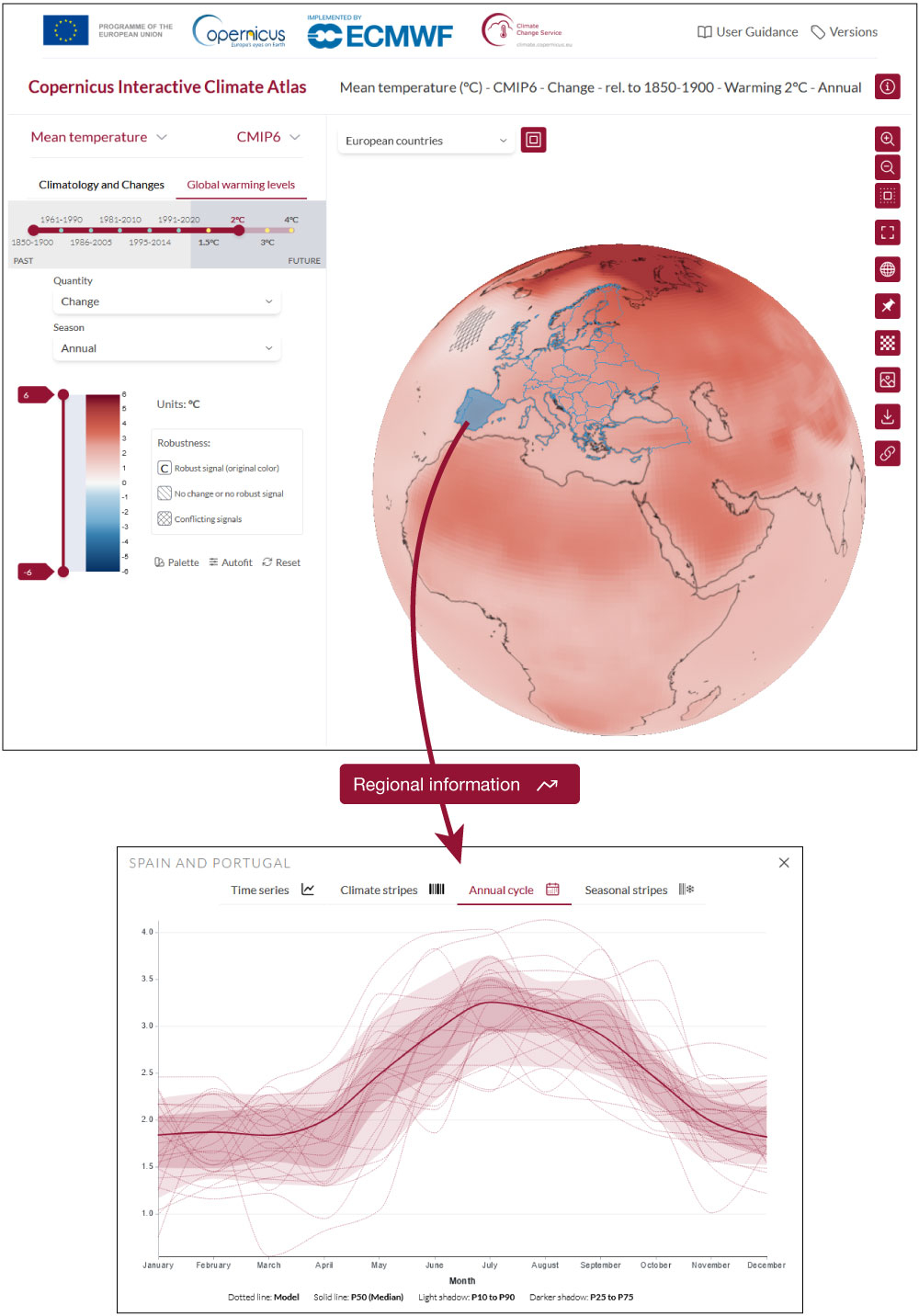
A
Summary information about the new features of the C3S Atlas
The new Copernicus Interactive Climate Atlas (C3S Atlas) is a C3S application which can be used to access and show authoritative datasets for monitoring and assessing the evolution of key climate variables and indices. This harmonised and processed information (common grids, calendars, etc.) is also published as an additional C3S dataset in the CDS. It ensures reproducibility and reusability and provides a generic dataset for climate change risk assessment. This data harmonisation, pre‑processing and quality control can help with the use of the data and can prevent any possible errors made in these steps by the users. It also facilitates downstream applications. Finally, it provides several new features with respect to any previously used tools in general and the IPCC‑IA in particular. Such features are:
- the possibility of selecting national and transnational regions, either predefined or user-defined, for detailed regional climate information
- periodic updates, including additional variables and indices (e.g. nine additional variables with respect to the IPCC‑IA in the first version: SPEI6, huss, evspsbl, mrsos, mrro, clt, rsds, rlds and psl – see Table 1 for the variable codes)
- using quality-assured datasets from the C3S CDS, such as ERA5-Land (in addition to ERA5 originally included in the IPCC‑IA) as a global reanalysis, the ORAS5 ocean reanalysis, CORDEX-CORE Regional Climate Model (RCM) simulations as well as regional EURO-CORDEX data, and Global Climate Models (GCMs from CMIP5 and CMIP6)
- the monthly dataset behind the C3S Atlas is fully available in the C3S Climate Data Store (CDS): https://doi.org/10.24381/cds.h35hb680.
Key variables for risk assessment
The C3S Atlas expands beyond the list of 21 variables/indices included in the IPCC-IA in order to better characterise key hazards. It thus supports and expands the global and regional climate change assessment made in the AR6 WGI report. Besides near-surface air and sea temperatures, precipitation and wind, the C3S Atlas includes additional essential climate variables, such as near-surface humidity, surface radiation fluxes, soil moisture and runoff, as well as various indices characterising different types of climatic impact-drivers. The selection of such new variables is based on the IPCC experience and particularly on user feedbacks on the IPCC‑IA. For ease of navigation and to improve the user experience, all indices have been grouped around common themes: heat and cold, wet and dry, wind and radiation, snow and ice, ocean, and circulation. The first version of the C3S Atlas included a total of 30 variables and indices (Table 1). Periodic updates are planned to incorporate new variables and indices aligned with C3S needs and with key international initiatives, such as the IPCC. The full description of variables and indices is available in the user guidance for the underlying dataset under ‘2.2 Variables and indices’ at: https://confluence.ecmwf.int/display/CKB/Gridded+data+underpinning+the+Copernicus+Interactive+Climate+Atlas%3A+Description+of+the+datasets+and+variables
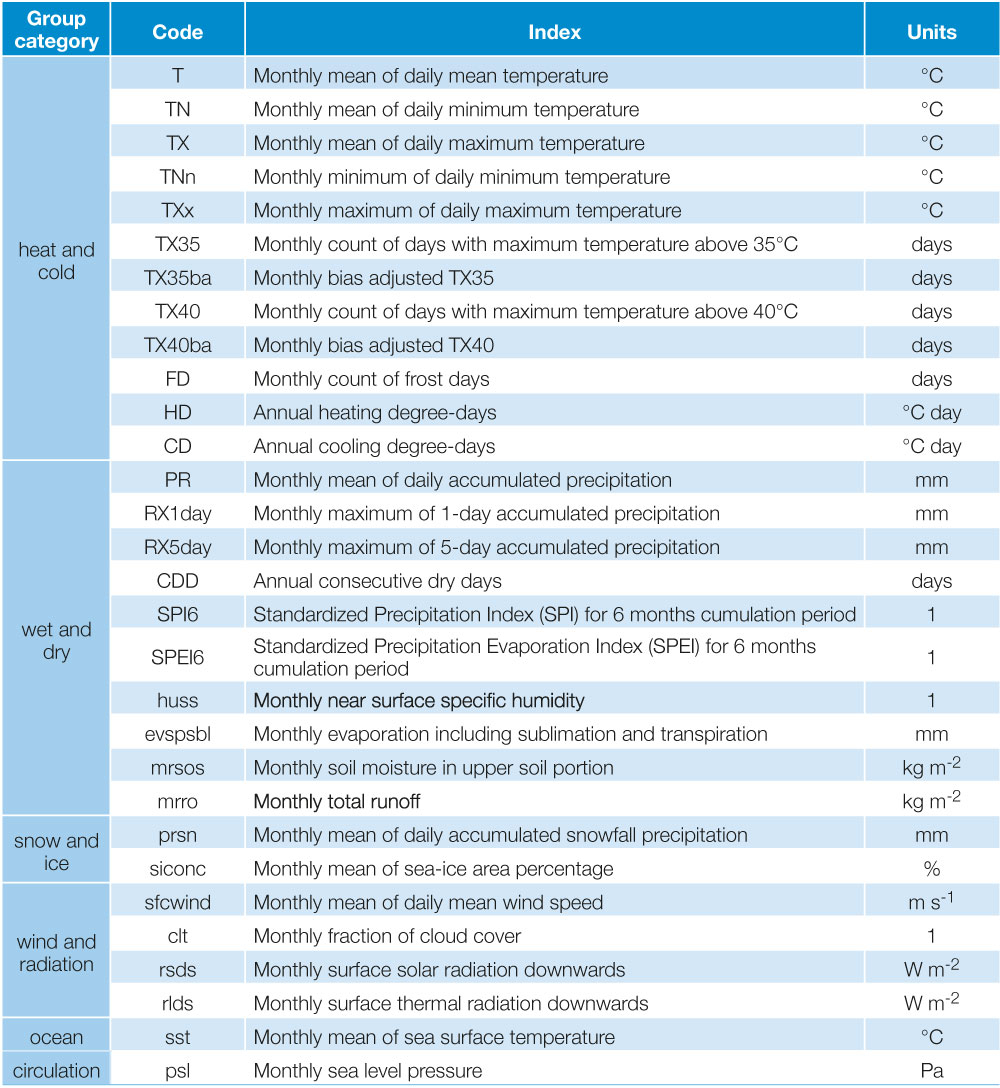
This set of 30 indices has been systematically computed (where data are available) for a number of authoritative and quality-assured C3S datasets (Table 2). They provide information about the past and present climate (observations and reanalyses) and our possible climate futures (global and regional climate projections), with key complementary lines of evidence for climate change risk assessment.
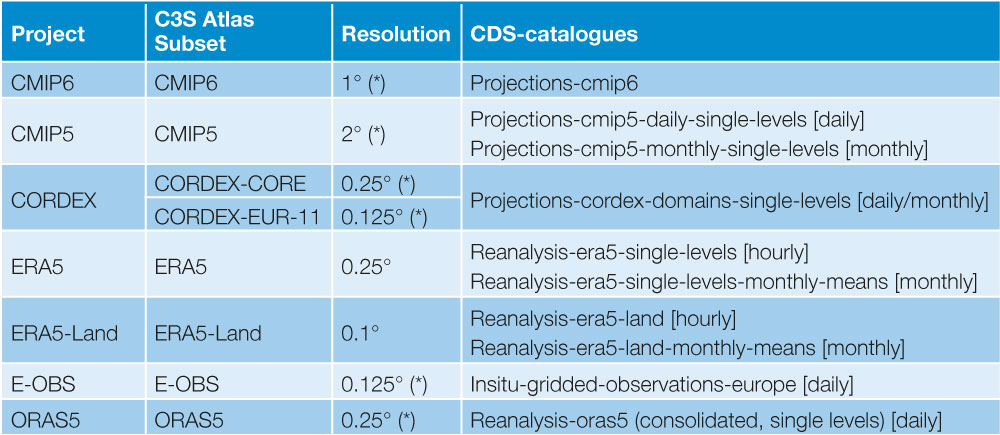
The C3S Atlas includes observation-based products, such as the E-OBS gridded observational database, which tracks temperature in Europe since 1950, as well as reanalyses like ERA5 and ERA5-Land. These reanalyses represent the state of our climate since 1940 (1950 for ERA5-Land). The application shows the data until 2022 and will be updated regularly, for instance every March, when all the data for the previous year are consolidated. Meanwhile, the near-real time ERA5 dataset ERA5T – up to five days before the current day – is available in the Climate Data Store. The C3S Atlas also includes ocean data (ORAS5 ocean reanalysis) from 1958 to 2014 to analyse the climatic conditions of different oceanic variables (sea-surface temperature and sea‑ice extent).
The Atlas includes state-of-the-art climate model projections to explore a variety of possible climate futures. They describe the evolution of the climate system based on simulations produced with Global and Regional Climate Models (GCMs and RCMs). They are forced with historical conditions and different future emission scenarios over the period from 1850 to 2100. The Coupled Model Intercomparison Project Phase 6 (CMIP6) is the reference framework for global climate projections and was essential to the work of the IPCC AR6. The application also provides access to the fifth phase of CMIP, CMIP5, which was the basis for the IPCC Fifth Assessment Report (AR5) and the special report for 1.5º global warming. This is still widely used as an alternative line of evidence.
Besides the global projections, the C3S Atlas also gives access to the regional projections created by the Coordinated Regional Climate Downscaling Experiment (CORDEX) driven by CMIP5 global forcings; in particular, CORDEX-EUR-11 high-resolution projections and CORDEX-CORE, complementing the CORDEX domain-by-domain information included in the IPCC Interactive Atlas. These two datasets provide the projections with the highest resolution available for the European domain (12.5 km) and for a global mosaic covering all land inhabited regions (25 km), respectively.
Downloading the visual products and the underlying data
A variety of options exist to download the visual outputs and the underlying data in user-friendly formats. Maps can be downloaded as PNG files and the underlying data as NetCDF, commonly used by climate practitioners, or GeoTIFF, commonly used by the Geographical Information Systems (GIS) community. All regional information products can be exported in PDF and PNG formats, and the underlying data (numbers) as a CSV file. All these products are distributed with an open licence, facilitating reusability.
Moreover, the entire dataset underpinning the C3S Atlas has been published in the C3S CDS catalogue (‘Gridded dataset underpinning the Copernicus Interactive Climate Atlas’, https://doi.org/10.24381/cds.h35hb680).
Discovering the C3S Atlas: an illustrative example
A selection panel with the main choices (see left in the top panel of Figure 1) is available to explore recent and future climate, including the selection of the variable, dataset, period of analysis, and part of the year (referred to as ‘season’, offering a choice between annual, seasonal or monthly). The selection of the dataset determines the details of analysis, which are different for observational and reanalysis datasets and for climate projections. The different options are described below using runoff as an illustrative example. Note that it is part of the set of variables (runoff, evaporation and soil moisture) included in the C3S Atlas to further characterise the hydrological cycle and hydrological droughts, thus extending and complementing the rainfall information originally included in the IPCC-IA. For observational and reanalysis datasets, the C3S Atlas offers climatologies, changes relative to a baseline period, and trends, for a number of predefined historical periods. The resulting information is graphically represented in the form of a map showing gridded information for the selected analysis period. Each dataset is shown in its full spatial extent (global or regional), with its corresponding spatial resolution. For instance, Figure 2 illustrates the possibilities of the C3S Atlas to analyse present climate conditions and recent changes for the annual mean daily runoff variable (kg·m-2, corresponding to mm for water) from ERA5-Land, showing consistent change and trend patterns.
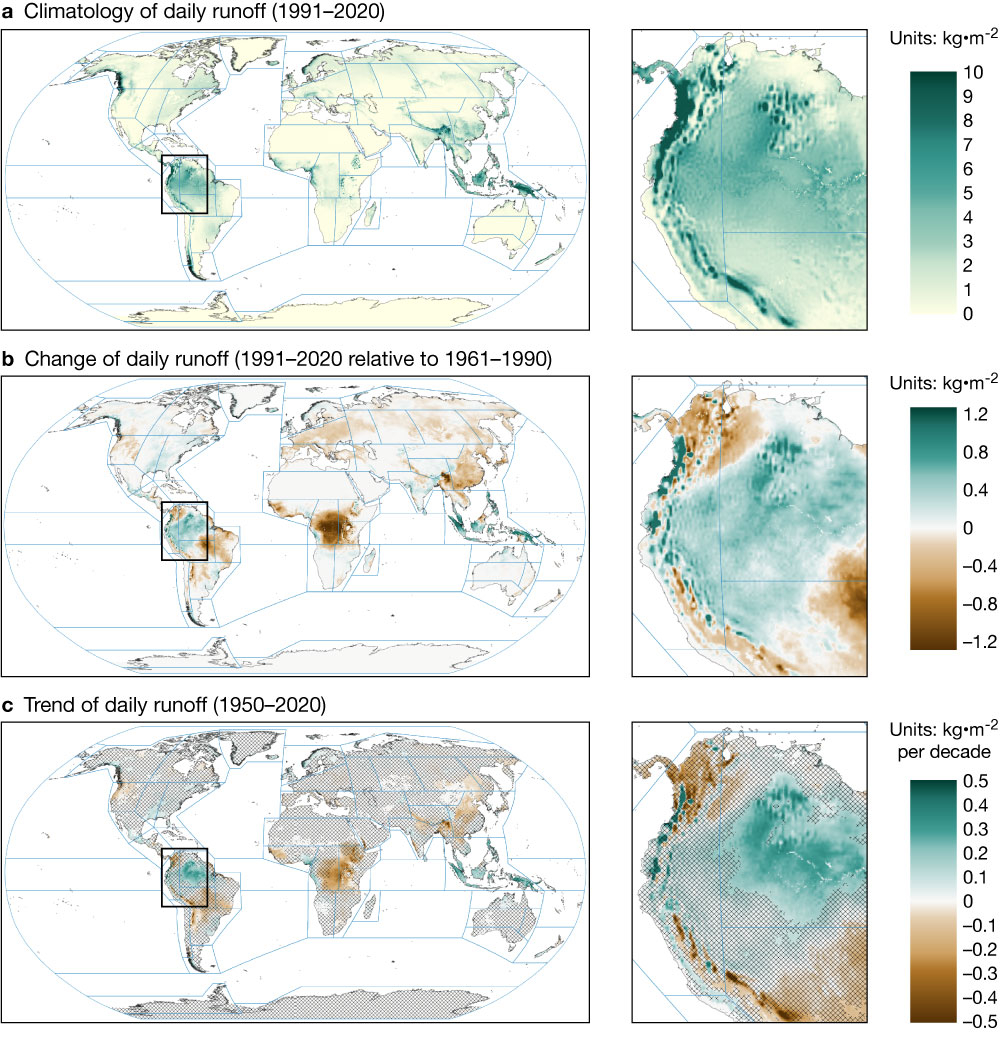
For the climate projection datasets, the C3S Atlas enables the display of climatologies and changes for historical periods, as in the previous case (see Figure 3).

Besides the historical periods, which can be used with observations and reanalysis, the ‘climatology and changes’ dimension makes it possible to explore future periods (near-, medium- and long-term, defined as 2021–40, 2041–60 and 2081–2100, respectively) across different emission scenarios: Representative Concentration Pathways (RCPs) for CMIP5 and CORDEX or the Shared-Socio-economic Pathways (SSPs) introduced for CMIP6. An additional dimension of analysis is the policy-relevant Global Warming Levels (GWL) used extensively in the IPCC AR6 report. In particular, the C3S Atlas enables the selection of 1.5°C, 2°C, 3°C and 4°C. Global warming levels have been computed, following the methodology used in the IPCC AR6 WGI Atlas, using the 20‑year periods when models first reach a particular global warming level relative to the pre-industrial 1850–1900 period. These periods are shown in the Atlas, as illustrated in Figure 4.
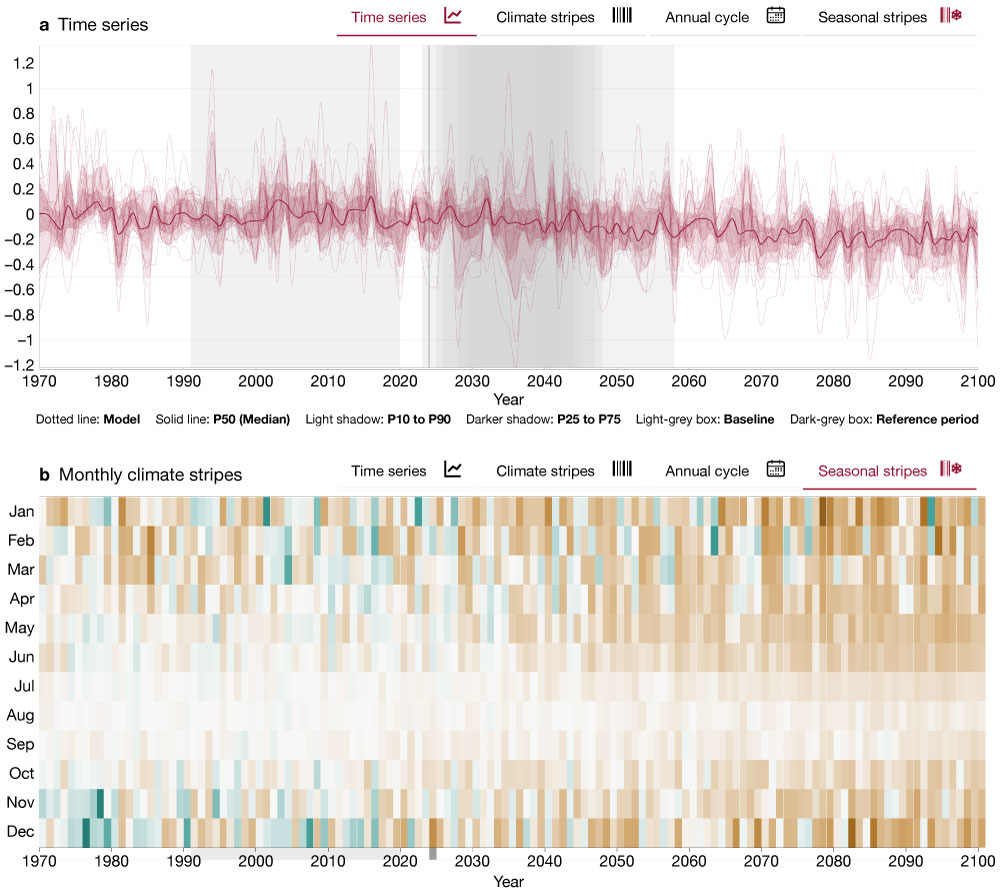
Figure 5 illustrates the use of the C3S Atlas to contrast different lines of evidence for future projections. It shows runoff changes according to the global CMIP6 ensemble and the regional CORDEX-EUR‑11 one. They provide consistent information for the future changes in runoff under global warming of 2°C, with respect to conditions in 1991–2020.
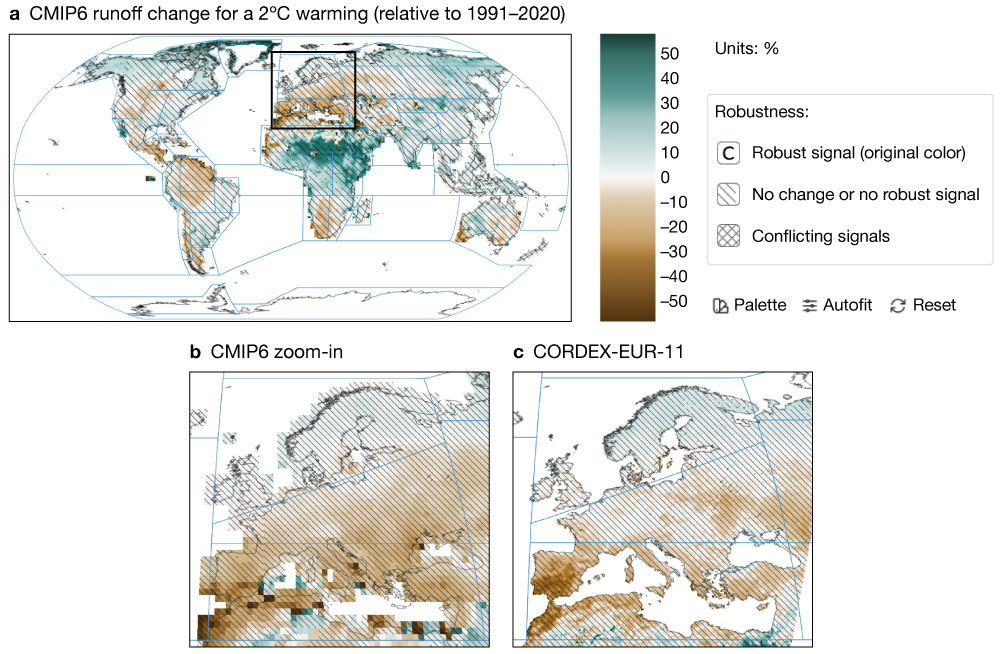
Climate change maps include information on the robustness or uncertainty of the displayed signal. Following the AR6 WGI method, the C3S Atlas uses model agreement (with an 80% threshold) and signal emergence (relative to internal variability) to provide three robustness categories: (a) robust signal, (b) no change or no robust signal, and (c) conflicting signal.
Detailed regional information with a variety of visual products
Beyond spatial map information, the C3S Atlas makes it possible to explore regionally aggregated information for a number of predefined regions, shown in the ‘region set’ selector. Single or multiple regions can be selected by clicking directly on the map. Predefined regions include:
- the IPCC AR6 reference regions, which were used in the AR6 WGI report for regional climate change assessment
- the EUCRA regions, which are used in the European Climate Risk Assessment, and
- European countries, including those countries covered by the regional European datasets: E‑OBS and CORDEX-EUR‑11.
The regionally averaged information shown by the C3S Atlas for these predefined regions is pre-computed and can be explored interactively by clicking the ‘regional information’ button, which becomes visible when a region is selected. The user can also select customised regions, which can be defined using the ‘user defined’ option in the region selector. A custom new region can be drawn directly on the map after clicking the ‘pencil’ button. This action creates an offline job which enters a queue system, passing through different states until completion, typically in a few seconds.
Complementary aspects of regional information are shown using different graphical products (Figure 4). All these graphical elements are dynamically updated when changing the choices in the selection panel.
FAIR principles for reproducibility and reusability
The development of the IPCC Interactive Atlas embodied a pioneering effort to integrate FAIR data principles (for Findability, Accessibility, Interoperability and Reusability) into climate policy reports (such as IPCC reports), thereby significantly enhancing their transparency and reproducibility (Iturbide et al., 2022). These principles have been adopted and expanded in the C3S Atlas by publishing the underpinning dataset in the C3S catalogue as described above, thus facilitating findability, accessibility, and reusability, and thoroughly documenting the data sources and processes used to produce the climatic products shown by the C3S Atlas. These activities will be complemented in the future by providing reusable code in Jupyter notebooks. These notebooks will illustrate the workflow followed to produce the C3S Atlas dataset and graphical products. Additionally, machine-readable standard provenance information will be provided for reproducibility. This information comprises a comprehensive description of the main climate data sources (primarily CMIP5/6 and CORDEX subsets), post-processing methods (such as temporal aggregation and regridding), calibration techniques (including bias adjustment), and graphical outputs (such as geographical extent, colour bars, and displayed entities and layers).
You can find all the practical navigation details of the C3S Atlas in the comprehensive User Guide: https://confluence.ecmwf.int/display/CKB/Copernicus+Interactive+Climate+Atlas%3A+User+Guide
Acknowledgement
This work has been funded by the Copernicus Climate Change Service (C3S) through the contract (C3S2_381) led by the Spanish National Research Council (Instituto de Física de Cantabria, IFCA) with the participation of the data management company Predictia. ECMWF implements C3S on behalf of the European Commission.
Further reading
Iturbide, M., J. Fernández, J.M. Gutiérrez, A. Pirani, D. Huard, A. Khourdajie et al., 2022: Implementation of FAIR principles in the IPCC: the WGI AR6 Atlas repository, Scientific Data, 9(629). https://doi.org/10.1038/s41597-022-01739-y
